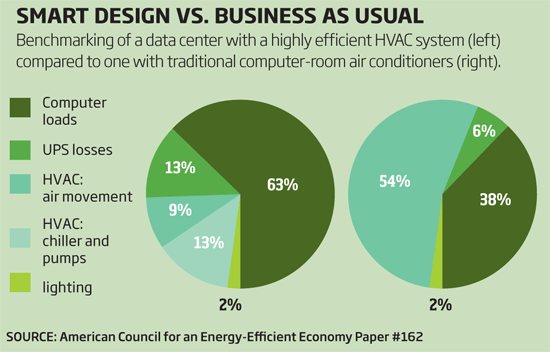The New Cool Data Centers
While PUE has become the accepted metric, it does not tell the whole sustainable story. It doesn't measure the energy efficiency of the servers themselves in accomplishing the desired action—be it a delivered email, a downloaded movie, or a financial transaction. It also does not differentiate between renewable and nonrenewable energy sources. And it gives no credit for projects that reuse the servers' waste heat for other purposes beyond the data center itself, such as heating habitable spaces in a neighboring building.
“There is an ongoing debate about measuring performance,” says Josh Hatch, director of sustainability analytics at Brightworks, a company based in Portland, Oregon, that has helped Facebook and other businesses incorporate sustainable practices. “Some people see PUE as a very successful metric, but others still see it as incomplete.” Although PUE is the most commonly referenced metric, others have been developed—not only for energy use but also for water efficiency and carbon footprint—to try to get a better handle on the full environmental impact of this building type.
Power Points
In conventional data centers, energy is wasted from the start, as it travels from the utility grid to the servers, because the electricity must be converted back and forth from alternating current to direct current and stepped up and down in voltage multiple times as it moves through the UPS, PDU, and various components within the IT equipment itself. Power is lost at each of these junctures. For its high-performance data center in Prineville, Oregon, which opened in 2011, Facebook customized power-supply equipment to eliminate the need for so many conversions. Meanwhile, researchers at LBNL are working with various manufacturers to create standardized products that would reduce the number of power-conversion requirements for the industry as a whole.
Energy waste in conventional data centers is also due to unnecessary redundancies and the inefficient use of servers: Multiple servers are typically kept running on standby just in case a portion of their computing capacity may be needed occasionally. So, in addition to purchasing the most efficient servers for their needs, IT staff must implement appropriate data-management strategies to minimize the total number of servers in operation.
 |
|
Chart by David Foster |









